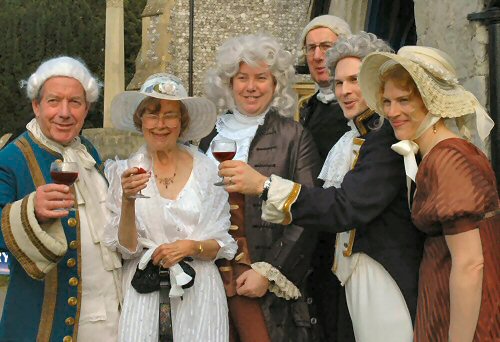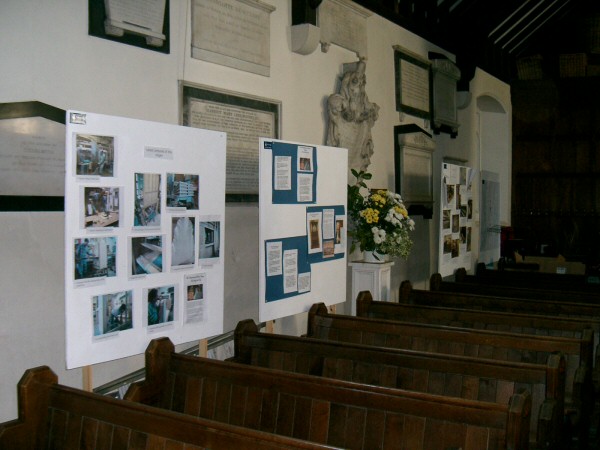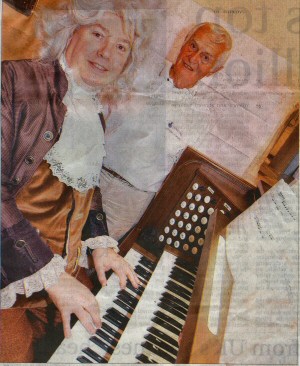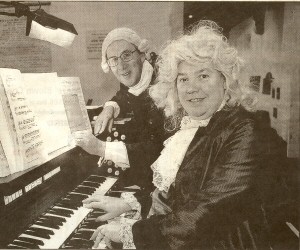Parish of Leatherhead - Thomas Parker Organ Restoration
Organ Matters - from the June 2006 Parish magazine:
In 1989 a fire in the North Transept of the Parish Church proved the final death knell of a large 19th Century pipe organ.
It had been in difficulty for sometime, due, at least in part, to poor maintenance. A professional report confirmed this analysis. Its restoration was thought to be too expensive and, in any case the organ was in the wrong place, the sound being lost in the side transept.
A Faculty was obtained to dismantle the organ and an Allen electronic organ has since been used to replace it. (A Faculty is a legal device granted by the Chancellor of the Diocese, currently Judge Andrew Jordan, enabling work to be carried out in a Parish Church, or introductions and changes to take place.) At the time it was hoped that a pipe organ would one day be reinstated in the Church.
When the organ was dismantled, Martin Renshaw, the organ builder who did the work, discovered that an earlier 18th Century organ* had been incorporated in the 19th Century one. Martin carefully preserved the 18th Century pipe work, manual keyboard and wind chest and these items are at present in storage.
Dominic Gwynn, of the organ builders Goetze and Gwynn Ltd, subsequently researched the 18th Century organ. It was originally made for Watford Parish Church by Thomas Parker in about 1766. It came to Leatherhead in 1843, purchased by the then incumbent, Benjamin Chapman and stood in a gallery at the west end of the Church.
Thomas Parker was a notable organ builder and in this sense what we have is a good quality and valuable musical instrument from a prime period of English organ building, by a doyen of organ building of that period.
The pipe work and other items lay for perhaps 15 years with no plans in mind. The reconstruction of the organ was going to be expensive and beyond the reach of our local resources. It became clear to me that if anything were to happen, the only source of funding to meet the costs would be the Heritage Lottery Fund. I asked Michael Lewis if he would make an application on behalf of the Church Council, which he subsequently did.
As I was able to report to this year's Annual Meeting, and thanks to Michael's careful preparation, that application was successful. It means that the Heritage Fund will grant up to £183,500 for the restoration of the Thomas Parker organ. The application was successful because it was recommended by an independent adviser as being of sufficient historical and musical importance to warrant undertaking. As part of the financial arrangement the Church Council would be responsible for raising 10% of the costs, up to £20,500.
The reasons for wanting to undertake this project are these:
It restores to the Parish Church a wind blow organ, which is a "proper" organ that breathes its own sound, and is not an artificially produced sound from an electronic source.
It is "our" organ, having been in this Church for over 150 years and part of the Church's heritage.
It will be a fine example, when restored, of an 18th Century instrument and will command attention from a wide field of those interested in Church music.
It will be a usable instrument and be played regularly on Sundays. It will also be available for concerts and use by the wider community.
In summary, the reasons for wanting to restore this organ are partly because of its historical importance. It is worth restoring in its own right as part of this Church's heritage. We value it for is own sake. But it is also a worthwhile project because it is an instrument that will be used for present day worship and music to which it can make a distinctive contribution.
The fact that the Heritage Lottery Fund have agreed to support, and almost entirely fund, the project should not be taken lightly. Many projects are refused and this is an offer that is unlikely to come again. It is a measure of the importance of the project that this funding is available. Here is a gift horse we should not turn away. It means some Church funding also being raised.
Should a Church be doing this? I am suspicious of those who say the Church should not be supporting a Heritage project of this kind; it is not our business. As Anglicans we recognise the importance of our heritage. That is why we value and maintain the Parish Church, a sacred place that carries our history and serves contemporary worship. We must also be concerned, and are, with mission of the Church and with people in need and the many other things and pursuits which make up Church life. But our concern is expressed in doing all of them, not some of them.
Music, the arts and heritage play a part in Church life alongside mission, education, and social action. All are important and have their place. That's why I am delighted that we are able to take up the opportunity to restore this very important part of our heritage. The Church contains items of historical and artistic merit but the Victorians stripped out much we would now want to preserve. Here is an opportunity to place in Church something of real value, to use and to enjoy, not only now, but also for generations to come. I commend the project to everyone who values music and the heritage we share.
In order to give an
opportunity to discuss this restoration and ask questions I
can offer Wednesday June 7th at 8pm in church when myself,
Michael Lewis and David Oliver will be present.
David Eaton
* Linda Heath, historian of the Parish Church, subsequently notes that the distinctive manual keyboard of this organ had for very many years been on display in the clergy vestry.
HERITAGE LOTTERY FUNDS TO RESTORE GEORGIAN ORGAN AT LEATHERHEAD PARISH CHURCH
The Heritage Lottery Fund (HLF) has awarded a grant of £183,500 - some 90% of the estimated total cost of restoring, and bringing into use an 18 Century Georgian Organ at the 11th Century Leatherhead Parish Church, St. Mary & St. Nicholas.
The organ parts were discovered in the early 1990s when a later Victorian Organ was being dismantled in the Church. Subsequent detailed examination revealed that the parts belonged to an organ first built in 1766 by Thomas Parker. Parker was a celebrated craftsman who was responsible for the construction of several organs of historical interest. These included the Great Packington Organ (located near Birmingham Airport) which was constructed on Handel's recommendations for the librettist of the Messiah, Charles Jennings. Parker is also reckoned to have made the small organ which is now in place in Merton College, Oxford.
The organ pipes, the soundboard and keyboard, from the Parker Organ were preserved and lay in storage for about fifteen years, at which point the Vicar of St. Mary & St, Nicholas, Canon David Eaton, thought an attempt should be made to restore the Parker Organ to its previous glory.
A former Churchwarden and retired businessman, Michael Lewis, agreed to make an application to the Heritage Lottery Fund. Much detailed work was required before the application could he submitted, but in the event the Heritage Lottery Fund were impressed by, and enthusiastic about the application and agreed to fund 90% of the required total cost of just over £200,000.
The Church Council, Church Organist David Oliver, and the Diocesan Advisory Committee were all very supportive of the restoration project, and the required Faculty was finally granted by the Chancellor of the Diocese in January of this year.
Canon David Eaton said
"We are all delighted that the Heritage Lottery Fund has
agreed to support in such a generous way the restoration of
this historically important instrument This is great news not
just for the Church but for the Town of Leatherhead in that
many members of the public will want to come and see the
restored organ, and hear it being played."
It is anticipated that work on the restoration, which is being undertaken by Goetze and Gwynn Ltd, one of the UK's leading restoration companies, will be completed by October 2007. During restoration work arrangements will be made to allow interested groups to view the organ reconstruction in the Church, and when the work is completed it is planned to hold regular organ concerts there.
St Mary and St. Nicholas Church have to raise some £20,000 in order to fully fund this project and fundraising activities are being organised by The Friends of the Parish Church. Donations in support of this restoration should be made payable to St. Mary and Saint Nicholas P.C.C., and fowarded to the Parish Office, Church Hall, Church Road, Leatherhead KT22 8AY. All donations will be gratefully received and acknowledged.
Tuning Up - March 2007
It has taken a long time to get there but we have finally made it. In January we received permission from the Chancellor of the Diocese, the senior legal officer of the diocese, to go ahead with the restoration of the 18th century organ, which originally came to Leatherhead in 1843. The then incumbent, Benjamin Chapman, purchased it from Watford Parish Church. The organ was discovered when the Victorian organ housed in the north transept was dismantled in 1989. The pipe work, soundboard and manual are preserved and will be housed in the new casing designed to an 18th century specification as shown in the line drawing. It will, of course, be a wind blown
pipe organ. Our present Allen organ, which we shall
retain, is electronic. The hope was expressed by the
Diocesan authorities who allowed the 19th century
organ to be removed, partly because of fire damage in
1989, that a real pipe organ would one day be
returned to the church. I am delighted that that is
now being achieved. |
 |
What did the Georgians do for us?
OK there was the steam locomotive and the railways, the first major road network since the Romans, the Industrial Revolution and, of course, Jane Austen. Yeah, but apart from all that, what did the Georgians do for us in Leatherhead? Well, one Georgian in particular, Thomas Parker, built us an organ. Not that special in itself maybe, but Parker wasn't an ordinary organ builder; he was an organ builder who got the great George Frederick Handel himself out of trouble after the organ Handel had personally commissioned to play the first versions of The Messiah broke down. Parker built the replacement, a much superior instrument, and Parker's organs are still revered as masterpieces to this day. The Leatherhead Parker organ was lost in a later Victorian instrument and became forgotten until a fire destroyed the larger organ and the older pipes were discovered and researched by an expert restorer. Our Parker organ has now been recognised as a potential national treasure; the Heritage Lottery Fund has stumped up £180,000 to enable us to rebuild it, but the Friends of the Church still have to raise a further £20,000 to complete the project. Once rebuilt, we will have a major asset, which will be an ornament not just to the Church but also to the ' wider community of Leatherhead. There is a long way to go but the restoration is already well under way, and to mark the official approval by the diocese of the project we will be holding an open early evening at the Church between 4pm and 6pm on Saturday 28th April. Our Director of Music, David Oliver, will play some highlights of Baroque/Georgian music and we will have some suitable refreshments available: spiced wine and ginger cake and some token Georgians on hand. |
 Members of Leatherhead Parish Church, including the Vicar and Musical Director, toast a successful Georgian Event at the Parish Church on 28th April 2007. This explained to the public why the restoration is taking place, the progress so far and the invaluable support we have had from the Heritage Lottery Fund. Refreshments were provided and music of the period was played on the present organ. image: Alison Wright
|
The real point of all this, though, is to share the enthusiasm for this wonderful project. Why not come along to see some pictures and plans, and some notes on the historical context of this exciting discovery?
We look forward to seeing you on 28th; pop
in after doing the shopping, maybe, and learn a little more
about our forgotten treasure.
The Friends of Leatherhead Parish Church
Organ Restoration Fund - from the May 2007 Magazine
There can be no one in our Church who has not heard about the restoration of our 18th Century organ, and since the Friends agreed to take over the fund-raising we have been most appreciative of those who, at the time of writing, have already contributed to our present total of just over £15,000. This amount, together with the tax recovery that Bernard has been diligently chasing up, means that we still need nearly £4,400 to reach our target of £20,500.
Who said, "the longest mile is the last mile home"? This very often applies to raising a particular sum of money, and I ask anyone who would still like to donate to help shrink our last few thousand pounds. Please come to the Georgian Late Afternoon experience on Saturday 28th April when plans and diagrams will be on show, and you can see where the money is going. You will be able to enjoy Baroque music from David Oliver and also "authentic Georgian" spiced wine and ginger cake.
Contributions can be sent to Bernard
Salsbury, 01372 375468, who will be most grateful to receive
any amount, no matter how large or small! Cheques should be
made payable to 'The Friends of Leatherhead Parish Church',
cash is also acceptable. Thank you.
Ron Presley OBE Chairman, Friends of Leatherhead Parish
Church
Links
Goetze and Gwynn Limited
Thomas Parker Organ restoration
project at Leatherhead

on-going information display in the church: Haslam
page last updated 5 Oct 2007

